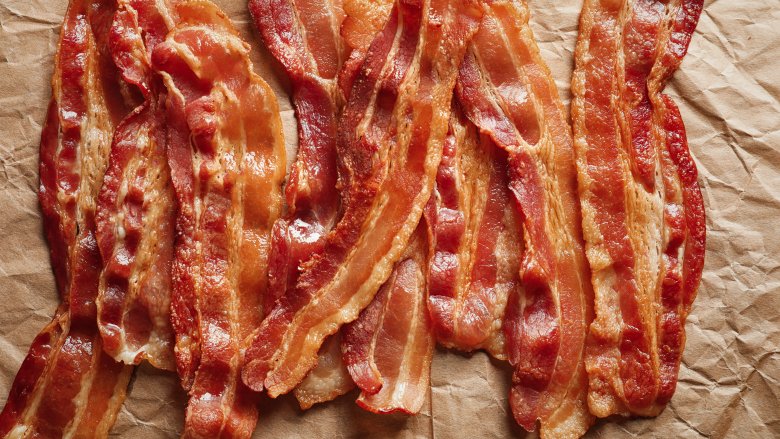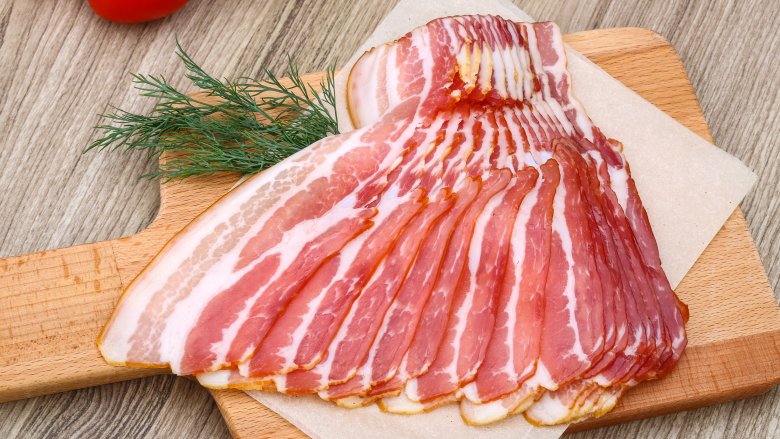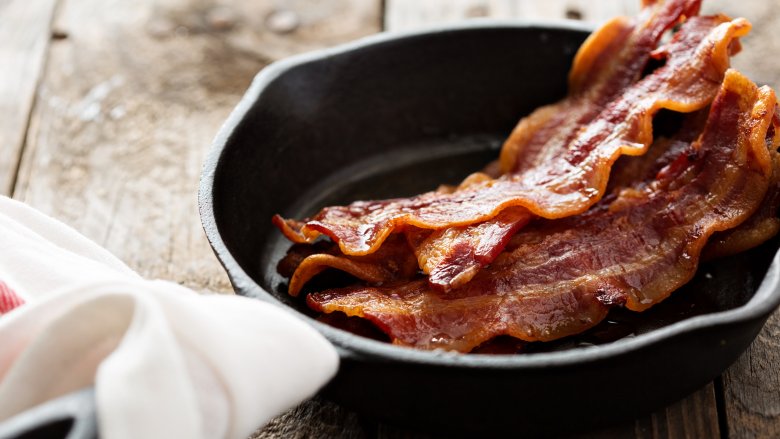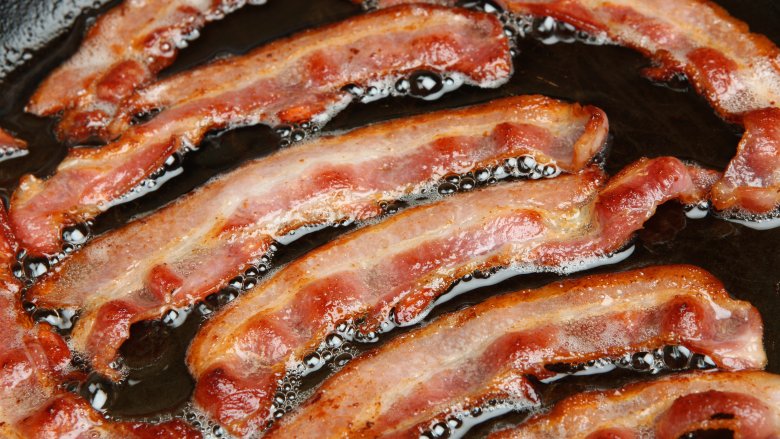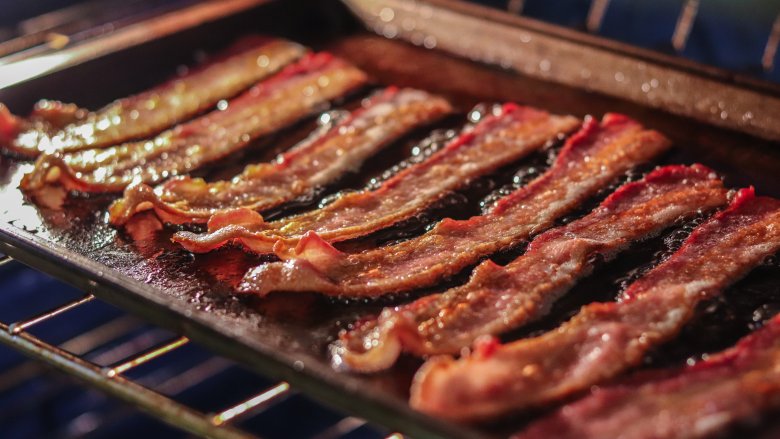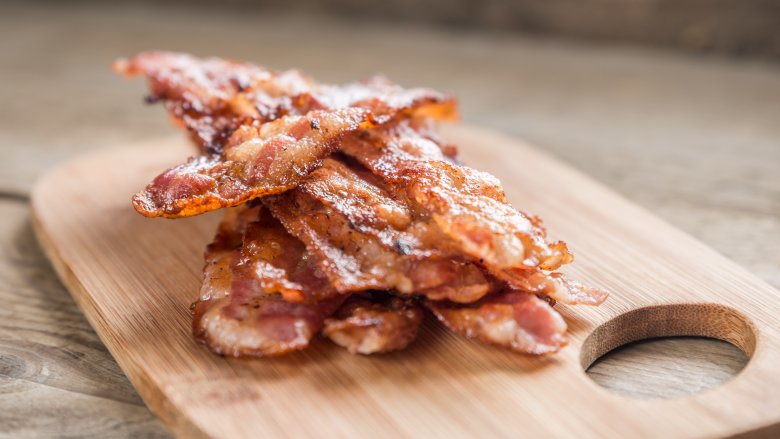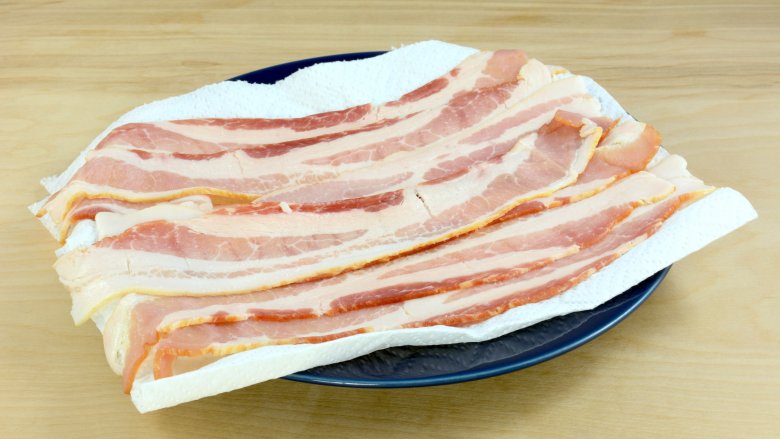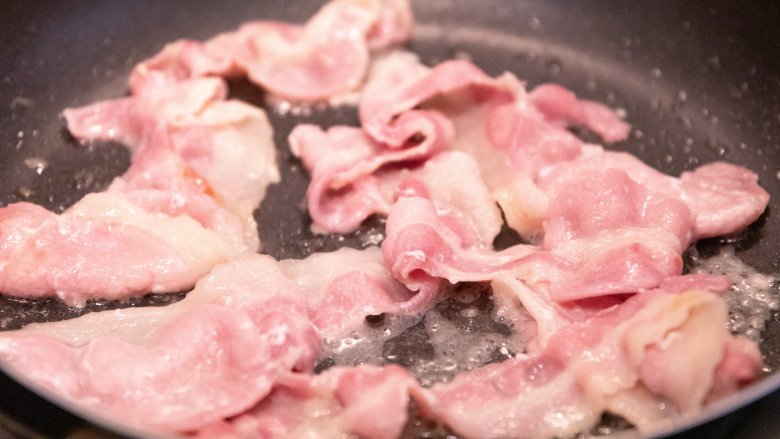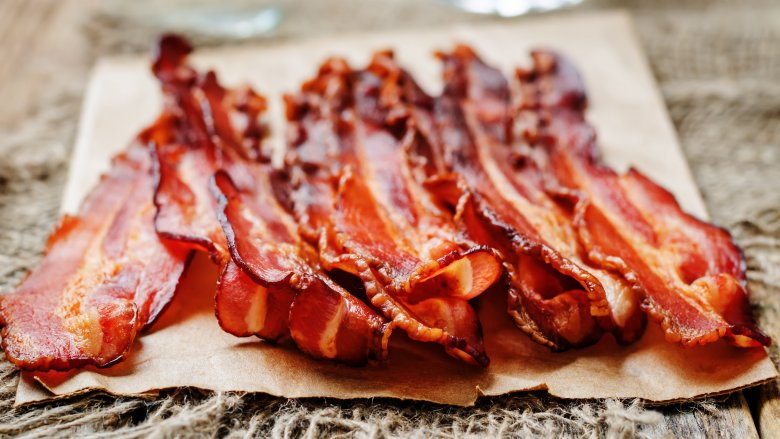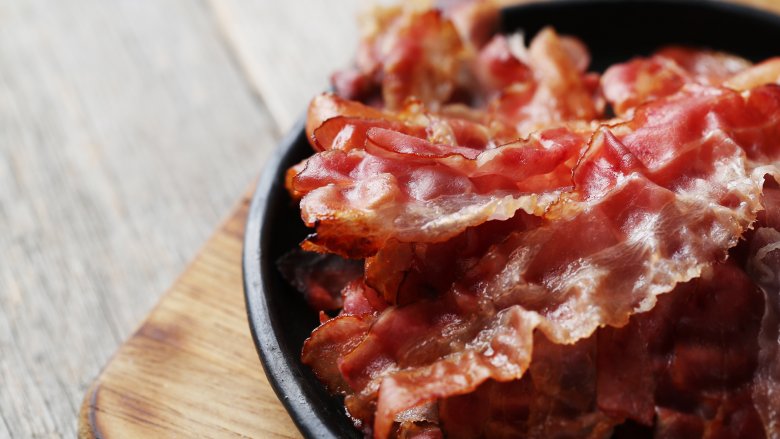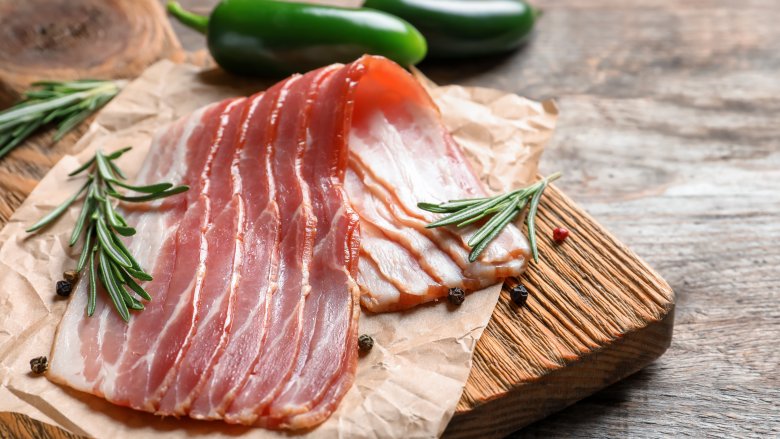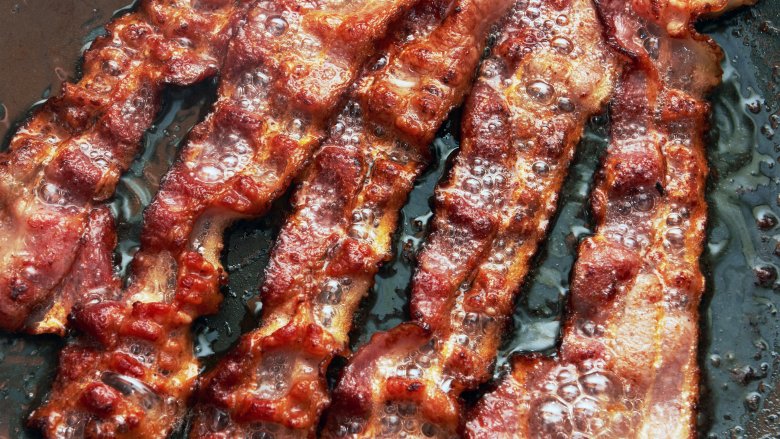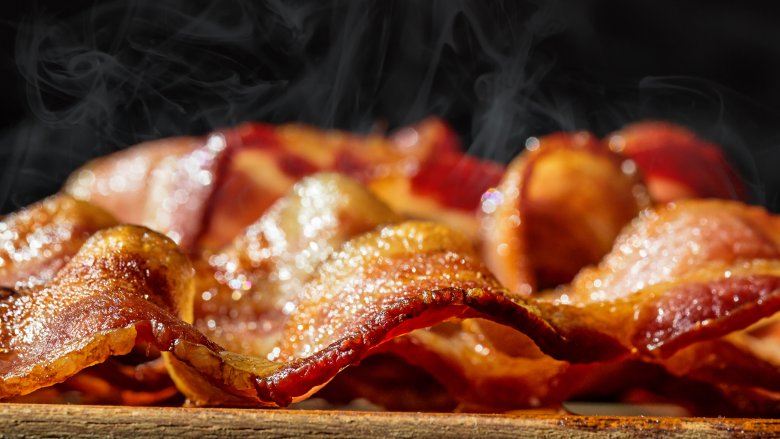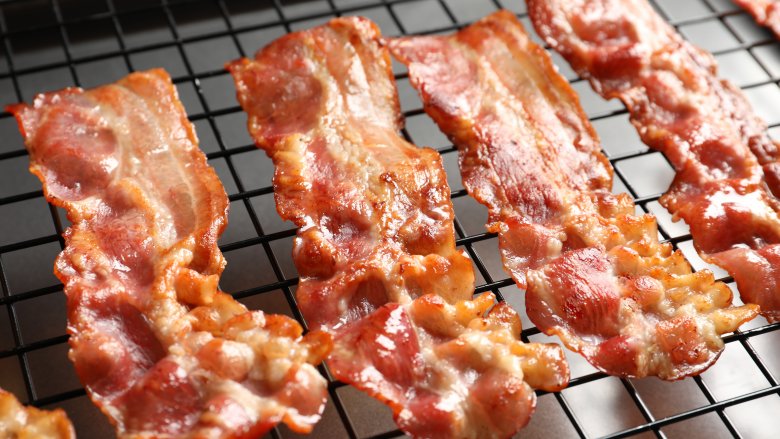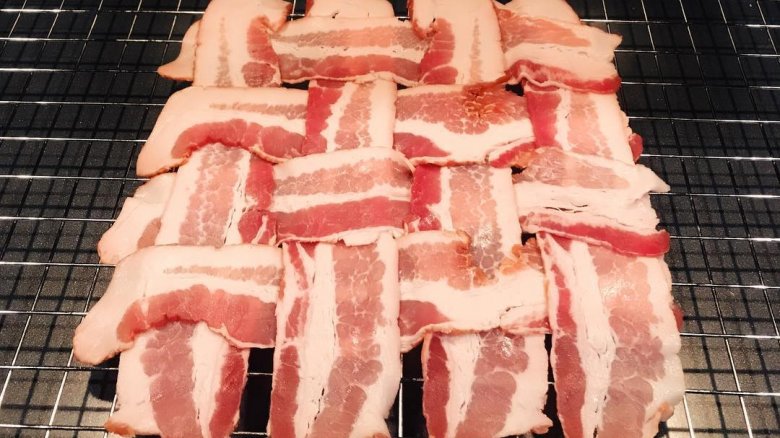The Biggest Mistakes Everyone Makes When Cooking Bacon
Bacon is, arguably, the best part of breakfast. When made right, it's the perfect combination of chewy and crispy, with tender meat and melt-in-your-mouth fat. But when it's made wrong? There is no place on the breakfast table for undercooked or overcooked, too limp or too crisp strips of subpar bacon. Maybe you think the words "subpar" and "bacon" couldn't possibly go together — after all, any bacon is good bacon, isn't it? No. There is, in fact, bad bacon, and it occurs when you make these mistakes in the cooking process.
From the way you're cooking it to the kind of pan you use and how hot that pan is, there are all kinds of ways you could be doing your favorite breakfast meat a huge disservice. Here's everything you're doing wrong with your bacon, and how to do it right, plus a few useful tips (including one from Prince Harry) that will take your bacon-cooking game over the top.
You're putting cold bacon in a hot pan
Mornings can be hectic, we know. But please do not try to shave a few minutes off your breakfast routine by heating up a pan over super high heat, and then throwing your straight-from-the-fridge bacon into it. Will you get cooked bacon using this method? Sure. Will you want to eat the bacon that results by using this method? Probably not.
The problem with the cold bacon-hot pan method is that all that glorious fat on those strips needs time to warm up and render out. If you toss cold meat into a hot pan, the fat immediately starts to seize up, resulting in bacon that has a gummy texture. For perfectly crisp strips with tender-but-not-gummy fat, start the bacon in a cold pan over medium-low heat, and take your time. Going low and slow ensures the fat will render out properly, and provides the bacon its own grease to cook and crisp in. Win, win.
You're using the wrong pan
So you're slaving away over the stove, cooking your cold bacon in a cold pan, low and slow, just like you're supposed to. But your strips aren't perfect, and they're even burnt in places. What gives?
Are you using an aluminum pan? When it comes to cooking bacon, not all pans are created equal. But by channeling your inner southern grandma, you'll be on the right track to expertly cooked strips every time.
The cast iron skillet is king when it comes to bacon, and that's because of its heavy bottom that evenly conducts heat. Gone will be those burned edges that you get when you use aluminum, which gets too hot too fast and is also prone to random hot spots. As an added bonus, every time you cook bacon in your cast iron skillet, all that luscious grease seasons the pan — proof that bacon really does make everything better, even cookware.
You're not adding water to the pan
This might seem like an odd way to ensure that your bacon is "crisp and tender, instead of dry and crumbly," but when America's Test Kitchen talks, we listen, and according to their experts, the secret to better bacon is water. Yes, really.
To make this next-level bacon, they recommend covering the meat with water and putting the skillet over high heat. Though we keep hearing that high heat is bad for bacon, here the water keeps that cooking temperature low, and allows the "meat to retain its moisture and stay tender." Once boiling, reduce the heat to medium and continue simmering until all the water has evaporated. Now reduce the heat to medium-low, and finish cooking the bacon until browned. The result? "Plump bacon that's pleasantly crisp, and not tough or brittle."
What is this magic? ATK explains that by the time the water reaches its boiling point, the fat is almost completely rendered out of the bacon, meaning you stand much less of a chance at burning the meat while trying to cook down the fat. Genius.
You're oven-cooking it wrong
Making bacon for a crowd is a pain — you can only cram so many strips into even your biggest pan, which means cooking it in batches. And nobody wants to be stuck at the stove while everyone else is enjoying their mimosas. The solution? Oven-cook one huge batch and go join your brunch guests.
Oven-cooked bacon seems fairly straightforward, yes, but there are plenty of methods out there, all claiming to be the best. Thanks to J. Kenji López-Alt at Serious Eats, who tested several of those methods, we now know which way is the best way. There are no wire racks, aluminum foil, parchment paper, or other tools required. Just a rimmed baking sheet and a 425 degree oven. Line up your strips, bake until crisp (about 20 minutes), and drain on paper towels. And don't worry, López-Alt says that this bacon is no greasier than other methods — so long as you don't skip that paper towel step.
If you just can't quit the wire rack method, consider following Alton Brown's advice to avoid the dreaded wailings of the smoke detector: "When roasting bacon at 400f try lining the pan with paper towels. They soak up the fat and prevent smoking." One downside here — no bacon grease to stockpile. You win some, you lose some.
You're not using a bacon press
What is the key to life-changing bacon? According to one GQ writer, it's a bacon press.
Yes, the simple, cast iron press, when coupled with a cast iron skillet, has that much of an effect on breakfast meat. Why? Because it allows each and every dip and curl of the bacon strip to come into contact with heat. As GQ's Josh Scherer explains, when you set a strip of bacon down in a pan, the wavy parts that aren't touching the cooking surface do cook, but only from the rising steam. Floppy, steam-cooked bacon means you miss you on all the melt-in-your-mouth fat and brown (but not overcooked) bits of meat. That's where the bacon press comes in.
Heat the pan for 2 minutes on medium heat (with a drizzle of vegetable oil). Here, the cold bacon-hot pan theory isn't an issue because the bacon is going to cook much more quickly — and more evenly. Put the strips in the pan, apply the press, and cook for about 5 minutes without touching. Flip, cook another 3 minutes, and you should have the most tantalizing bacon you ever laid your eyes on, with "edges [that] are crispy but not burnt."
Not only does the bacon press produce totally flat strips of perfectly cooked bacon for sandwiches, it also cuts the cooking time down considerably. Two good reasons to make room for this kitchen gadget.
You're microwaving it wrong
Depending on who you ask, microwaving bacon can be a polarizing subject. While Bon Appétit implores, "Just... no. Please don't," others think it produces a perfectly edible final result. As with any cooking method, your chances at a good result greatly improve by doing it the right way. Here's how to microwave your bacon so you don't regret it...
Many methods will have you use several layers of paper towels in the process, meant to absorb all the grease. The downside to this, aside from the waste, is that although they do do a good job at soaking up the fat, the cooked bacon can stick to the paper towels. To avoid the stick factor, and a greasy mess, drape the strips around the edge of a bowl, place the bowl on top of a larger plate, then microwave until crisp. The fat drips into the bowl or onto the plate, and the bacon stays crisp. Sure, you've got a couple extra dishes to do, but no piles of paper towels to throw out.
You're cooking the wrong amount
You're going to feel a bit like Goldilocks here, but to make the best bacon, you've got to cook the just right amount — or risk a major breakfast fail.
Though it might be tempting to get the job done fast and throw a bunch of bacon into the pan at once, it turns out that doing so is actually a recipe for disaster. According to Bon Appétit, you need to leave about an inch of space around each strip, which ensures that the the fat renders out and gives the bacon a chance to crisp up, rather than steaming in its close quarters and becoming limp and soggy.
On the other hand, cooking too few strips of bacon can also end badly. Scott Vermeire of Prather Ranch Meat Co. explains on Chowhound that cooking just one or two pieces of bacon doesn't allow enough fat to render out quickly enough, and therefore the pan doesn't stay lubricated. The result? Scorched bacon. Nobody wants that.
You're not cooking it like Prince Harry
Although the royals have some weird rules about food, they are apparently free to eat all the bacon they want. And as we've learned from a former royal chef, if that bacon is destined for Prince Harry's plate, it needs to be cooked a certain way.
Chef Darren McGrady explained to Food & Wine that 8-year-old Prince Harry taught him a thing or two about how to cook the breakfast meat after a trip to Disney World. "It was after [the royal family] came back from Walt Disney World, and I had cooked bacon for breakfast," he said. "We serve the same bacon you can get in the states, and I broil it just the same. But Prince Harry said to me, 'We had it in America at Disney World, and it's so crispy you can snap it. You have to broil it first, and then you have to put it in some paper towels and place it in the microwave for a minute.' And I thought, yeah, OK, thank you, you little brat, teaching me how to cook. But as soon as he was gone, I tried it, and I got this amazingly crispy bacon."
For his part, McGrady says he never went back to his old ways of cooking bacon, and used the broil plus microwave method from then on. Score one for Prince Harry.
You're cooking it in an air fryer
Yes, air fryers are all the rage these days, and yes, many air fryer evangelists swear that the machine cooks bacon perfectly. But not all air fried bacon attempts have gone so smoothly, and you may want to consider this before you pop a few strips into your new favorite small appliance.
Cooking Light tested out a Philips Viva Collection HD9621 Air Fryer (different brands and models may yield different results), and unfortunately, rather than perfectly cooked bacon, ended up with a whole lot of smoke and "sad, lifeless bacon" that was destined for the trash can. Elizabeth Laseter, who attempted the air fried bacon, noted that the machine "started spewing out thick white smoke" just a few minutes into cooking. After lowering the heat, and even after putting a bit of water in the bottom drawer as some recommend, the tray continued to fill up with bacon grease and smoke heavily.
Laseter concluded that though the machine might work exceptionally well for already-fried foods, with something like greasy bacon it's a whole other matter completely: "You're essentially just filling up your air fryer with rendered bacon fat that ends up burning and smoking to a point where it's practically unsalvageable," she said.
You're not flavoring it
Plain ol' bacon is great — don't get us wrong. But every once in awhile it's fun to switch things up, and it turns out that flavoring your own bacon is easier than you thought.
When you make flavored bacon, you'll want to cook it in the oven, as this allows you to easily brush on the flavoring mixture, and eliminates the need for constant flipping. The Kitchn recommends using a foil-lined baking sheet (which will make the cleanup of any burned-on ingredients much easier), and cooking the bacon in a 400 degree oven for 15-20 minutes before draining the fat from the pan. At that point, you're free to brush on any concoction your heart desires. Cook for 5 more minutes, and boom, flavored bacon.
Try a classic combination like maple syrup and chipotle chili powder (or cayenne for a kick), or go bold with a mixture of Sriracha, sesame oil, and honey. How about roasted garlic bacon? It's as easy as spreading those creamy cloves right onto the strips. The possibilities really are endless.
You're not saving the grease
Aside from the deliciously salty meat itself, the second best thing that results from cooking up a big pan of bacon is the grease. Bacon grease is the secret ingredient all kitchens need — you can fry your eggs in it, you can use it in salad dressings, you can use it in soups, stews, cookies and caramels. Honestly, you can use it in pretty much anything you cook. Therefore, one of the biggest mistakes you can make after you cook your bacon is throwing out that liquid gold.
While your grandma probably kept a tin of fat in her cabinet, you might, understandably, want to abide by more stringent food safety measures. In that case, it's as simple as pouring the grease through a strainer, and sealing it up in a container to store in the fridge (but no flavored bacon fat, please). The magic of bacon grease is that even when cold, it's still nice and pliable, ready for whatever your needs may be — even if it's just spreading it on a piece of toast.
You're not getting rid of the smell
Perhaps the one and only negative thing you can say about bacon is the lingering scent it leaves behind. Yes, it's a small price to pay for such a tasty morsel, but some would rather not inhale the smell of greasy meat all day long. Thankfully, there are a few ways to abolish the offending odor.
For starters, make sure you're doing the bare minimum while cooking: 1. Use a splatter shield, which helps cut down on the particles that get into the air and latch onto your countertops and walls. 2. Run the exhaust fan on your stove, and, weather permitting, open the windows.
After that, be sure to clean the kitchen of any residual grease, as oils smell worse once they turn rancid. Wipe down any surfaces that may have been hit by splatter, wash the dirty, bacon fat-infused dishes, and toss or launder any towels used in the cleaning process.
Lastly, if you're really committed to ridding your home of any and all bacon smells, whip up a homemade aromatherapy spray by filling a spray bottle with water and adding 10 drops each of eucalyptus, lemon, and lavender essential oils. Spray this wonder concoction around your stove, run the fan for a few minutes, and voila, no more greasy bacon odor.
You're not freezing it
Let's face it — the bacon cooking process can result in a pretty big mess. Whether you're using the stovetop, oven, or microwave, there's splatter, piles of paper towels, and pools of grease to clean. But hey, it's delicious bacon, so it's worth it. There is a way to minimize the mess, though.
Next time you're in the mood for bacon, commit to cooking the entire package — or two for that matter — at once. Whether you make 12 strips or 24, you'll still only have one mess to deal with. Once the bacon is cooked (the oven works well for big batches), let it cool. All these perfectly cooked strips are now ready for the freezer.
The goal here is to ensure the bacon strips freeze individually, so that you can grab however many you need. To freeze the bacon, lay wax paper onto a baking sheet, and line up the strips so they're not touching. Depending on how much you have, you may need to add another layer of wax paper on top and start a new row of bacon. Once frozen, store them in a zip-top bag for up to one month. Whenever you need it, just microwave the frozen bacon for about 30 seconds to restore it to its hot, crispy glory, and bonus, there's no big mess to clean.
You're not making a bacon weave
A bacon weave, really? Though it might look a little silly, it's more than just a bacon-lover's gimmick — it's actually a genius cooking hack that you should be using on the regular, and believe it or not, this piece of lattice-work meat is the answer to many of your culinary woes, including dried-out meatloaf.
With a bacon weave, inadequately topped burgers with a few measly strips slipping off the patty are a thing of the past. Add one to any sandwich (hello, better BLTs) or burger and you'll guarantee a substantial amount of salty meat with every mouthful. And then there's the bacon-wrapped chicken, meatloaf, burger patties, or pork loin. You can use a bacon weave to encase oven-roasted or grilled meat and poultry, and not only does it add impressive flair, it also adds tons of flavor and keeps foods from drying out. Win, win.
It's easy to do, too — just weave full or half strips of bacon like a lattice until you've formed a large enough square, then either bake it flat until crisp (if using as a sandwich topper), or wrap around the dish to be cooked.
